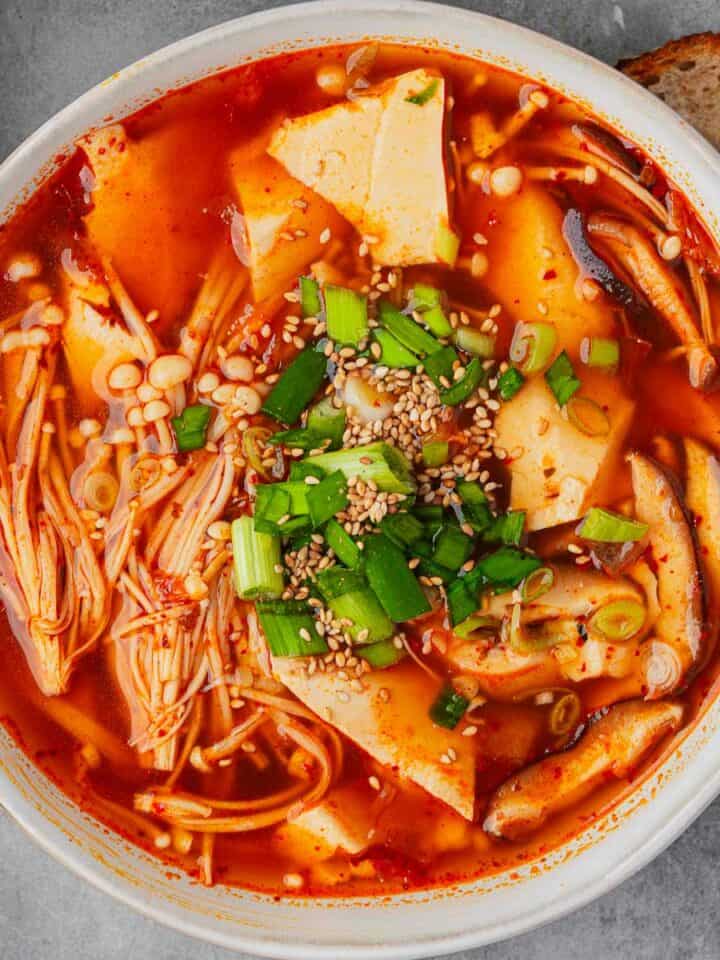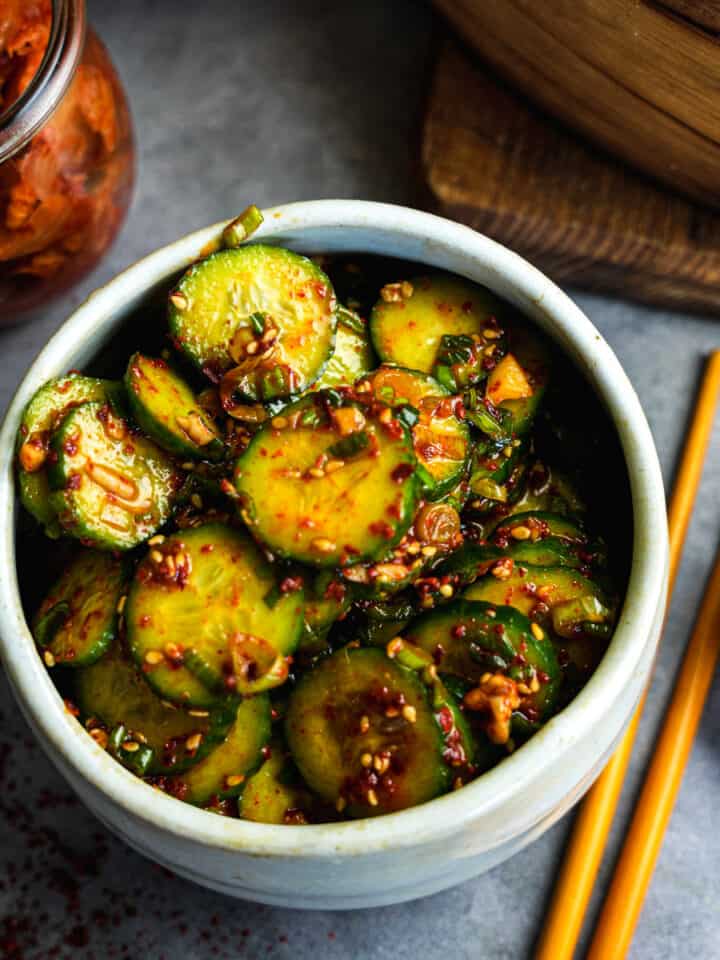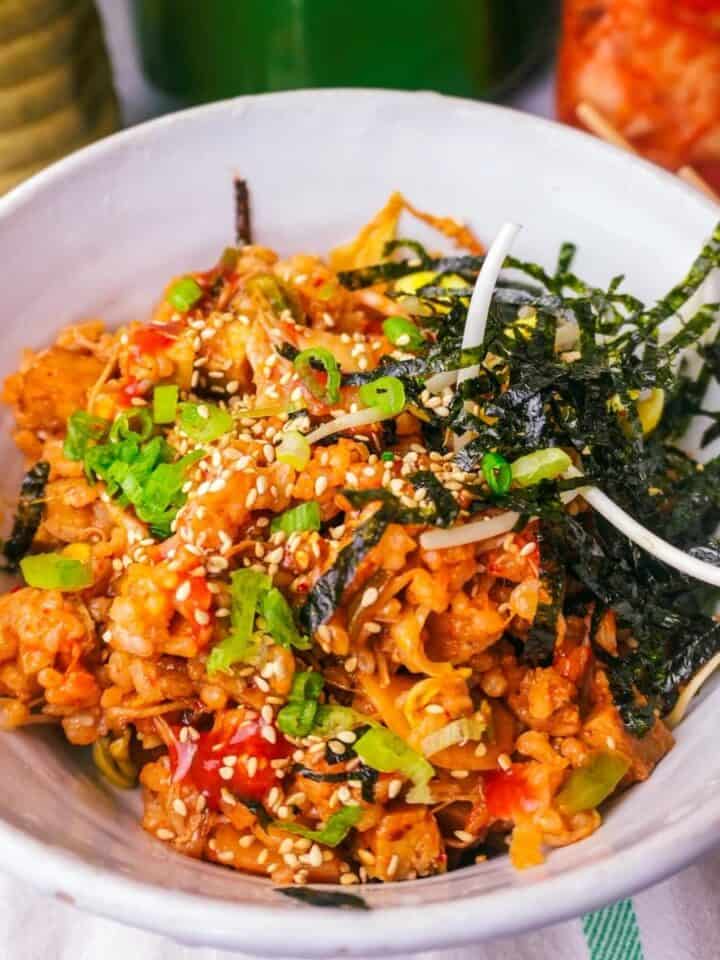*This post may contain affiliate links. Read more »
Listen, I get it. You’re thinking, “It’s just carrots.” But trust me—Morkovcha isn’t some sad, rabbit-food situation. Korean carrot salad is the definition of low effort, high reward. Ten minutes, a handful of ingredients, and BOOM—you’ve got a bright, crunchy, garlicky, slightly spicy salad that makes everything on your plate instantly better. It’s tart, a little fiery, and borderline addictive.


Enter your email & I'll send it to your inbox. Plus, get great new recipes from me every week!
By submitting this form, you consent to receive emails from Cinnamon Snail.
Now, let’s talk history—because surprise, this salad isn’t actually from Korea. Plot twist! Morkovcha (or Morkov po-koreiski) was created by Korean immigrants living in the Soviet Union. Traditional kimchi ingredients and gear weren’t easy to find, so they worked with what they had—carrots, vinegar, garlic, and spices—and just like that, a new classic was born. Over time, it spread across Russia, Ukraine, and beyond.
So, if you’ve ever spotted it at a Russian deli and wondered, “Why is there a Korean salad in here?”—now you know. And while Morkovcha sits comfortably next to vegan borscht in Russian food culture; its punchy flavors have way more in common with vegan kimchi fried rice or vegan bulgogi than anything Eastern European.
This recipe nails the balance of flavors on the first try. No sad, boring AF carrots here. Make a whole batch now, and thank yourself later when you’re piling it on top of everything in sight.
Jump to:
🥰 Why you’ll adore this Korean Carrot Salad recipe
✅ Tested and Approved Worldwide: Like all of the vegan recipes I share, this one’s been made, tweaked, and perfected by recipe testers from all over the world, so you know it’s gonna turn out right.
⏳ Fast & Foolproof: The hardest part of this recipe? Waiting for the flavors to come together. All you need is 10 minutes of active prep, and the fridge does the rest.
✊ Vegan AF & GF: Like all of my vegan Korean recipes, this one has no fish sauce, no honey, no sneaky animal-based nonsense. Just pure, spicy Korean carrots packed with umami, maximum-flavor, and sesame-infused deliciousness.


👩🍳 Learn to make the BEST vegan Korean food
This 5-day guide to my most popular Korean recipes is 100% FREE, & you'll love the actual heck out of it 🥰
🥕 Korean Carrot Salad Ingredients

Carrots
Carrots are obviously the heart of this dish. While orange carrots are typical, you can also use multicolor carrots, like I opt for when I make balsamic-roasted brussels sprouts and carrots (because, hello- PRETTY). If you are a lazy bum, pre-shredded ones work, but they won’t absorb the dressing as well, and will not stay fresh for as long either.
Salt
Salt does more than season here—it’s used in the brining step to pull out excess moisture, making the carrots more tender and flavor-absorbent. Don’t worry, though—most of it gets rinsed off, so your salad won’t taste overly salty.
Tamari
Tamari adds a savory, umami depth without overpowering. Unlike soy sauce, it’s naturally gluten-free, but if gluten isn’t an issue for you, regular soy sauce, coconut aminos, or shoyu all work fine in this recipe.
Rice Vinegar
This mild, slightly sweet vinegar adds a punchy brightness that makes everything pop without the complicated, or time-consuming need for fermentation (as is the case with Indian carrot pickle). No rice vinegar? White vinegar or apple cider vinegar will also do the trick.
Gochugaru
These Korean chili flakes bring the signature heat and deep red color to the salad, with a mild, smoky spice that lingers without overpowering.
No gochugaru? No problem. Aleppo pepper makes a great substitute—it’s mildly hot, slightly fruity, and delivers a warm, smoky depth. It’s also a key ingredient in Ezme and Mercimek Köfte, where its subtle heat adds the perfect kick. If you’re mad about heat, feel free to add ¼ to ½ teaspoon cayenne pepper.
Toasted Sesame Oil
This oil brings nutty aroma and richness, and helps the dressing coat every strand of carrot for maximum flavor. Make sure you’re using toasted sesame oil (darker in color) rather than plain sesame oil, which is more neutral. It’s a must-have for Korean dishes, but it also shines in dishes like Sunomono (Japanese Cucumber Salad), and Thai Basil Eggplant, where it brings a warm, toasty depth to every bite.
*See the recipe card at the bottom of the page for exact quantities, nutritional info, and detailed cooking directions.
📖 How to make Korean carrot salad
Nail this easy carrot salad recipe on your first shot by following these step-by-step photos with helpful tips. Or scroll down to the bottom for the easy-to-print recipe card.

Step One
Shreddy Krueger:
Using a mandoline, spiralier or by hand with a sharp knife, cut the carrots into long julienne strips.

Step Two
Brine & Prejudice:
Place the julienned carrots in a large bowl. In a separate container, dissolve the salt in the water, then pour it over the carrots. Let them soak for 30 minutes to slightly soften so they absorb the dressing better.

Step Three
Drain Spotting:
Once brined, drain the carrots and rinse them thoroughly under cold water until they no longer taste salty. Pat them dry with a clean towel to remove excess moisture.

Step Four
Whisk-tory in the Making:
In a small bowl, whisk together the sugar, tamari, rice vinegar, gochugaru, and toasted sesame oil until the sugar completely dissolves.

Step Five
Slaw and Order:
Transfer the carrots to a mixing bowl, pour the dressing over the top, and toss until every strand is evenly coated. If you're using garlic chives (I strongly recommend it!), mix them in now.

Step Six
Leaf It Alone:
Serve it at room temperature or chilled. The flavor and texture improve as it sits.
💡 Serving Ideas
Morkovcha fits right in with a classic banchan spread—those small, flavor-packed side dishes that bring balance to any Korean meal. Rock it out with oi muchim (spicy-sour Korean cucumber salad) for a fresh, crunchy contrast, or go all in on fermented goodness with vegan kimchi and kkakdugi (a type of kimchi made from Korean radishes) for an extra hit of tang and funk. A little Korean scallion salad on the side? Heck yes.
For mains, this banchan lineup shines next to bold, comforting dishes. A bubbling bowl of Sundubu Jjigae (spicy tofu stew) brings warmth and richness to the table, while Korean braised tofu adds deep umami with a garlicky, savory contrast. If you’re craving something crispy and saucy, vegan Korean fried chicken is a solid choice, or go smoky with vegan drumsticks slathered in Korean BBQ sauce. And because no great meal ends without a little sweetness, kkwabaegi—light, fluffy, twisted Korean donuts—are the perfect finish (or dessert is the new appetizer, as my wife Joey would have it).
👉 Top tips
- Choose the Right Carrots: Opt for thinner firm carrots with a bright orange color; they offer the best sweetness and crunch, ensuring your salad has that perfect crisp texture.
- Master the Julienne Cut: Use a mandoline, a spiralizer, or a julienne peeler to slice the carrots into uniform, thin strips.
- Massage the Carrots: After adding the dressing, give the carrots a gentle massage. This helps the carrots become more tender and absorb the flavors of the dressing.
- Let It Marinate: While the salad can be enjoyed immediately, allowing it to sit in the refrigerator for a few hours, or even overnight, makes the flavor and texture even better.
🤷♀️ Recipe FAQs
Korean Carrot Salad, also known as Morkovcha, is a vibrant dish featuring julienned carrots marinated in a zippy, spicy dressing. Originating from the Korean diaspora in the former Soviet Union, this salad combines elements of Korean culinary traditions with local influences, resulting in a unique and delicious side dish.
Nope! Despite the name, Korean Carrot Salad—Morkovcha (Морковча)—isn’t actually from Korea. It was created by Koryo-saram, ethnic Koreans who migrated to the Russian Far East in the 19th century. When Stalin forcibly deported thousands of them to Central Asia in the 1930s, they had to adapt their traditional recipes with what was available. Napa cabbage and chili pastes were hard to come by, but carrots? Plentiful. Their crisp texture made them the perfect stand-in, soaking up bold seasonings and creating something familiar, but entirely new.
The result was a vibrant, tangy, slightly spicy carrot salad that captured the essence of Korean flavors while seamlessly fitting into Soviet cuisine. Over time, Morkovcha became a staple across Russia, Ukraine, and other post-Soviet states, popping up in markets and home kitchens. It became a go-to for special occasions, celebrations and holidays, bringing the perfect fresh contrast to heavier, oilier dishes.
Today, it stands as a true cultural mash-up—born out of necessity, shaped by migration, and beloved across generations. Whether it’s brightening up a plate of hearty mains, stuffed into sandwiches, or served alongside other banchan, Morkovcha is proof that some of the best dishes come from unexpected places.
To julienne carrots, peel them first, then slice them into thin, matchstick-sized pieces. This can be done with a sharp knife, a mandoline with a julienne attachment, or a specialized julienne peeler. Using a mandoline is the best way to get the most uniform cuts, but a well-sharpened knife works well if you have the patience and skill.
Mandolines, however, are no friggin' joke. They’re insanely sharp and can go from slicing carrots to slicing fingertips in seconds. Always use the hand guard, keep your fingers away from the blade, and work carefully with your full attention.
In my years working in restaurants, I’ve seen some tragic accidents with mandolins and meat slicers. A great salad isn’t worth a trip to the ER.
While pre-shredded carrots offer convenience, they will lack the crispness and freshness of freshly julienned carrots. For the best texture and flavor, and better keeping quality, take the time to make ‘em yourself, you lazy ol’ bum.
Oil is kinda a key component in the dressing of Korean Carrot Salad, helping to carry the flavors and provide a pleasing mouthfeel. But yeah, if you are one of my WFPBNO (whole foods plant-based, no oil) readers, feel free to leave it out.
This salad actually gets better as it sits—so meal prep away! Here’s how to store and, if needed, refresh it before serving.
❄️ Refrigeration:
Store Korean Carrot Salad in an airtight container in the fridge for up to 10 days. The flavors deepen over time, so it’s best after at least a few hours of marinating. Give it a quick toss before serving to redistribute the dressing.
✌️You'll love these vegan Korean recipes too:

Korean Carrot Salad (Morkovcha) Recipe
Ingredients
To brine:
- 2 lbs. carrots peeled and julienne cut or shredded
- 2 tablespoons salt (don’t worry, this rets rinsed out!)
- 2 cups water
Dressing:
- 5 teaspoons sugar
- 2 ½ teaspoon tamari
- 3 tablespoons rice vinegar or white vinegar
- 4 teaspoons gochugaru (Korean chili flakes)
- ¼ cup toasted sesame oil
- ½ cup chopped garlic chives or scallions
Instructions
- Place the julienned carrots in a large bowl. In a separate container, dissolve the salt in the water, then pour it over the carrots. Let them soak for 30 minutes.
- Drain and rinse thoroughly under cold water until no longer salty tasting. Pat dry with a clean towel.
- In a small bowl, whisk together the sugar, tamari, rice vinegar, gochugaru, and toasted sesame oil until the sugar dissolves.
- Transfer the carrots to a mixing bowl. Pour the dressing over the carrots and toss until evenly coated. If using, add the chopped garlic chives and mix well.
- Let the salad sit for at least 30 minutes before serving to allow the flavors to develop. Serve at room temperature or chilled.
Notes

Enter your email & I'll send it to your inbox. Plus, get great new recipes from me every week!
By submitting this form, you consent to receive emails from Cinnamon Snail.











Marna says
I resorted to my trusty, ancient Cuisinart food processor (which I acquired on Craigslist and swear by) and then simply grated the whole 2 LBS. No, it does NOT look as cool as Adams BUT it worked! It worked fast and easy and held up fine in the Brine, which I was worried about. So, Carrot salad consensus? Mind you, 2 lbs. of carrots makes a huge bowl grated....and there were NO left overs. All GONE, what does that tell you?
Kimbi Walton says
Terrific side dish. I plan to bring it to potlucks now that I know how easy and taste bomby it is!
Reshyll says
Tried making this carrot salad and it's totally addictive. I’d eat it as a snack any day.